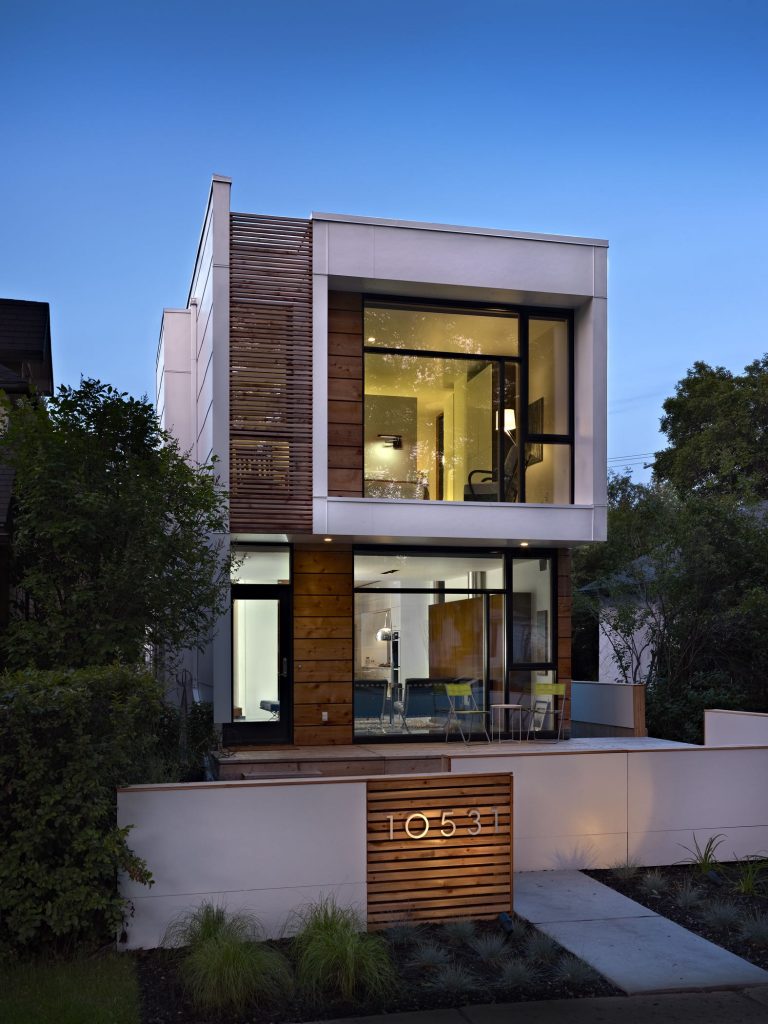By David Dodge and Duncan Kinney
Building a net-zero home is an intricate dance between design, technology and location. But if you build a net-zero home in the wilds, far from your work, school and entertainment, with no infrastructure and an hour-long commute how sustainable is it?
This series is called Chasing Net-Zero in recognition of how close we are to consistently building houses that produce as much energy as they consume. But it turns out location, location, location is as important as the design of your home when it comes to reducing your energy footprint.
Small is beautiful

Louis Pereira designed LG House as an innovative infill home that was built on a small, 25-foot lot, perfect for a lower impact urban lifestyle
We visited LG House, the personal residence of Louis and Giselle Pereira. Louis is an architect and owner of thirdstone, a home design studio based in Edmonton, Alberta.
Pereira’s home is energy efficient and beautiful, but it’s not net-zero. Pereira is redesigning inner city homes to fit on smaller lots and help revitalizing older communities while supporting a sustainable lifestyle in the process.
“Net-zero to me is minimizing your footprint and developing a house that is going to be very responsible environmentally. Whether that means using less energy or taking up less square area in your development, there are a lot of advantages in developing in infill areas where the infrastructure is already there. You’re more centrally located, closer to amenities,” says Pereira.
When he talks about using less space, he’s not kidding. He built his 2,400 square foot home on a 25-foot lot that the city had previously declared as insufficient, inadequate and substandard. Pereira’s home building permit was initially rejected by the city but after talking to neighbors he appealed the decision and succeeded in building his beautiful small footprint home.
“We went from a two car household to needing one vehicle. So we’re less car dependent. Because we’re located where we are we’re closer to amenities. You can easily walk to work, the school is nearby as well. So our kids can even walk back and forth from school,” says Pereira.
With his full-sized home on a half sized city lot Pereira is creating a more affordable alternative for families to revitalize inner city neighbourhoods, making use of existing and expensive urban infrastructure such as schools, parks and transit.
While it’s not a net-zero house it’s far more energy efficient than your standard suburban home. It has triple glazed windows, an insulated foundation and it takes advantage of passive solar heating and cooling. It’s green footprint comes from its location and the lifestyle it supports.
Solar Decathlon – driving net-zero innovation forward

The Cenovus Spo’pi Solar House was built by a team of 100 University of Calgary students and entered into the solar decathlon competition in Washington DC in 2011. The purpose is to build an affordable, net-zero, solar powered home. Photo David Dodge https://www.greenenergyfutures.ca/episode/79-chasing-net-zero-net-zero-beautiful
The Solar Decathlon was started by the US Department of Energy in 2002 to prove that a solar-powered, sustainable home was possible.
In just one decade that mandate has evolved from proving solar works to designing, building and operating a solar powered house that is affordable, energy efficient and attractive.
Kim Gould was a member of a 100-member University of Calgary team that built the Cenovus Spo’pi Solar House, an entry in the 2011 Solar Decathlon competition.
Her team raised $1 million to design a net-zero home that can be built for $300,000.
“This house was designed for the Treaty 7 communities of southern Alberta and it’s rounded responding to the traditional forms of the buildings you would see,” says Gould, who is now a junior project manager with Pivotal Projects, in Calgary, Alberta.
Their first big challenge put the engineers on a collision course with the architects – to make solar work on a curved roof shaped like a turtle. In the end, the 8.7 kilowatt solar array is only five per cent less efficient that if every panel was at the perfect angle, and there’s more than enough energy to cover all of the energy needs of this 1,000 square foot, two-bedroom house.
The Spo’pi home is well insulated, has energy efficient appliances and uses an electric powered air source heat pump for heating and a simple electric hot water heater for hot water (check the Solar Decathlon page for more details).
Gould is only a few years out of University and even she is surprised by the pace of change: “When you’re looking at the economics of solar how much more viable solar photovoltaics on the home have become even over the course of the past two years the gains are just astonishing.”
It’s innovation like this that has helped net-zero homes become commonplace in just one decade. As for Kim Gould: “My involvement with this house really did shape where I ended up going with my career and with the previous house. It got me interested in renewable energy, it got me interested in finding a company that really had that involvement in the green building industry.”
There is no net-zero formula and everyone approaches it in their own way. But when you home goes beyond being passive energy consumer it changes the game in how you look at houses.
This is part two of our four part series called Chasing Net-Zero. Our next episode explores how simple, passive energy systems are the key to creating affordable, sustainable homes of the future.
Click here to see the full screen Flickr slide show for this gallery.


